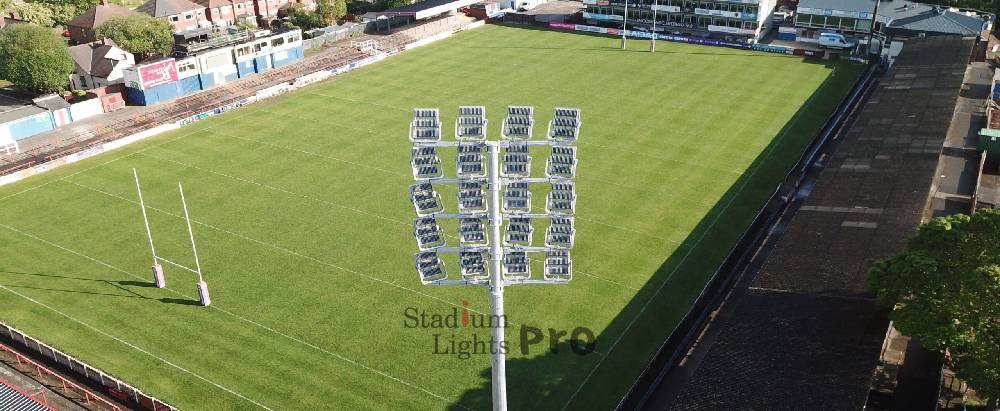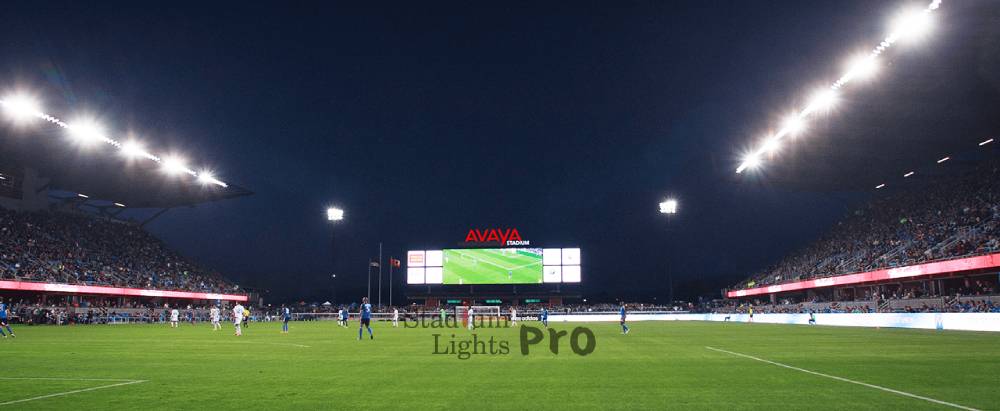For any sports or entertainment venue, stadium lighting ensures that events can be safely and enjoyably held at any time of day, while also enhancing the experience for spectators, athletes, and performers. However, the high costs of installing or upgrading stadium lighting can be a significant barrier. Grants can be a vital solution, providing the financial support needed to make these projects possible. By securing grants, venues can improve their quality and boost their economic, social, and environmental impact. This comprehensive guide will cover where to find grants for stadium lighting projects, the importance of these grants, the types available, the application process, and strategies for leveraging them for success.
Table of Contents
ToggleThe Importance of Grants for Stadium Lighting Projects

Enhancing Financial Feasibility
Stadium lighting projects often come with substantial costs, including the purchase of high-quality lighting fixtures, installation, maintenance, and potentially even environmental impact assessments. For many organizations, whether they are public entities, non-profit organizations, or private businesses, these costs can be a significant barrier to making necessary upgrades or new installations. Grants provide crucial financial assistance, reducing the burden on these organizations and enabling them to pursue projects that might otherwise be out of reach. By covering part or all of the costs associated with stadium lighting, grants make it possible to achieve better lighting standards that enhance visibility, safety, and the overall experience for users and spectators.
Promoting Community Development
Stadiums often serve as central hubs for community activities, including sports events, concerts, and other large gatherings. Proper lighting not only enhances the safety and functionality of these venues but also contributes to community pride and cohesion. Grants for stadium lighting can, therefore, have a broader impact beyond the immediate financial relief they provide. They can help stimulate local economies by making the stadium a more attractive venue for events, which can bring in visitors, create jobs, and generate revenue for local businesses. Moreover, improved lighting can allow the stadium to host a wider variety of events, increasing its utilization and maximizing its value to the community.
Environmental and Energy Efficiency Benefits
Modern stadium lighting projects often aim to incorporate energy-efficient technologies, such as LED lighting, which reduce energy consumption and minimize environmental impact. However, the initial costs of these technologies can be higher than traditional lighting systems. Grants can help offset these costs, making it more feasible for organizations to adopt sustainable practices. This not only reduces the long-term operational costs associated with energy consumption but also aligns the stadium with broader environmental goals, such as reducing carbon footprints and promoting sustainable development. By securing grants for energy-efficient lighting, stadiums can become leaders in environmental stewardship, setting a positive example for other community projects.
Types of Grants for Stadium Lighting Projects
Government Grants

One of the primary sources of funding for stadium lighting projects is government grants. These can come from various levels of government, including federal, state, and local agencies. Government grants are often designed to promote public infrastructure improvements, community development, and energy efficiency, making them an ideal source of funding for stadium lighting projects.
At the federal level, grants may be available through agencies such as the Department of Energy (DOE), which offers funding for energy-efficient projects, or the Department of Housing and Urban Development (HUD), which may provide grants for community development initiatives. State and local governments may also offer grants specifically aimed at improving public facilities, enhancing community safety, or promoting environmental sustainability. These grants can be highly competitive, so it’s important to carefully research the available options and ensure that your project aligns with the grant criteria.
Non-Profit and Foundation Grants
Another significant source of funding comes from non-profit organizations and foundations. Many foundations are dedicated to specific causes, such as community development, environmental sustainability, or youth sports. These organizations may offer grants to support projects that align with their mission, making them a valuable resource for stadium lighting projects that aim to enhance community engagement or promote energy efficiency.
For example, the U.S. Soccer Foundation offers grants to support the development of soccer facilities, including lighting improvements, with a focus on providing safe and accessible environments for young athletes. Similarly, the Green Sports Alliance, which promotes sustainability in sports, may offer grants or other financial assistance for projects that incorporate green technologies, such as energy-efficient lighting.
Non-profit grants may be smaller than government grants, but they can be easier to obtain and can often be used to supplement other sources of funding. Additionally, partnering with a non-profit organization can enhance the visibility and credibility of your project, which can be beneficial when seeking additional support.
Corporate and Private Sector Grants
Corporations and private sector entities are increasingly offering grants and sponsorships for community projects, including stadium lighting. Companies may provide funding as part of their corporate social responsibility (CSR) initiatives, particularly if the project aligns with their brand values or business objectives. For example, a company that manufactures lighting equipment might offer grants or discounts to support projects that showcase their products.
Additionally, companies involved in the energy sector, such as utility companies or renewable energy providers, may offer grants to promote the adoption of energy-efficient technologies. These grants can be a valuable resource for projects that aim to reduce energy consumption and minimize environmental impact.
Corporate grants can also come with additional benefits, such as in-kind contributions, technical support, or marketing opportunities. For example, a company might provide the lighting equipment at a reduced cost or offer expertise in designing and installing the lighting system. In return, the stadium might feature the company’s branding, providing valuable exposure and demonstrating the company’s commitment to community development.
Application Procedures for Stadium Lighting Grants
Researching Available Grants
The first step in securing a grant for stadium lighting is to thoroughly research the available options. This involves identifying potential funding sources, understanding their eligibility criteria, and determining how well your project aligns with their goals. Start by looking at government websites, foundation directories, and corporate CSR reports to find relevant grant opportunities.
It’s important to note that some grants may have specific requirements, such as focusing on energy efficiency, community development, or youth sports. Ensure that your project meets these requirements before applying. Additionally, pay close attention to application deadlines and any required documentation, such as project proposals, budgets, or letters of support.
Preparing a Strong Grant Proposal
Once you’ve identified a grant that aligns with your project, the next step is to prepare a strong grant proposal. This is arguably the most critical part of the process, as a well-crafted proposal can make the difference between securing funding and being rejected.
Your grant proposal should clearly articulate the goals of your stadium lighting project, the benefits it will provide, and how the grant will help achieve those goals. Be sure to include detailed information about the project’s scope, timeline, and budget, as well as any environmental or community impacts. It’s also important to demonstrate that your project is feasible and that you have the capacity to successfully implement it.
Include any supporting documentation that may strengthen your proposal, such as letters of support from community leaders, technical assessments, or case studies of similar projects. If applicable, highlight any partnerships with non-profit organizations, government agencies, or private companies, as these can add credibility and demonstrate broad support for your project.
Navigating the Application Process
The application process for grants can vary depending on the funding source, but it typically involves submitting your proposal and any required documentation, followed by a review process. Some grants may require an initial letter of intent, which is a brief summary of your project and its alignment with the grant’s goals. If the grantor is interested, they may invite you to submit a full proposal.
During the review process, your proposal will be evaluated based on various criteria, such as the project’s alignment with the grant’s objectives, its potential impact, and the feasibility of its implementation. Be prepared to answer any follow-up questions or provide additional information if requested.
If your proposal is successful, you will receive a grant agreement outlining the terms and conditions of the funding. Be sure to carefully review this agreement and ensure that you comply with all requirements, such as reporting on project progress or using the funds for their intended purpose.

Optimizing Grant Opportunities for Success
Maximizing Economic Impact
Grants can serve as a powerful catalyst for economic growth by enhancing the overall appeal and functionality of your stadium. Improved lighting can significantly elevate the stadium’s attractiveness as a venue, making it more appealing to event organizers looking for a well-equipped, versatile space. High-quality lighting not only enhances the spectator experience but also allows for a broader range of events, including night games, concerts, and community gatherings, thereby increasing the stadium’s usage and revenue potential.
When a stadium becomes a more desirable venue, it naturally draws in larger events and more frequent bookings. This increase in activity leads to higher ticket sales, greater concession revenues, and increased demand for merchandise, all of which contribute to a stronger financial foundation for the stadium. The economic benefits extend beyond the stadium itself, positively impacting the surrounding community. Large-scale events can attract visitors from outside the area, leading to increased business for local hotels, restaurants, and retail establishments. This influx of visitors can provide a significant boost to the local economy, supporting jobs and generating additional tax revenue for the municipality.
Furthermore, showcasing the economic impact of your stadium lighting project can be a compelling argument when seeking further financial support. By demonstrating how the project will drive economic activity and benefit the local economy, you can build stronger relationships with local businesses, government officials, and community leaders, who may become valuable advocates for your project. These partnerships can lead to additional funding opportunities, whether through grants, sponsorships, or other forms of financial backing, ensuring the long-term financial health and sustainability of your stadium.
Enhancing Social and Community Benefits
Grants for stadium lighting projects also offer a unique opportunity to enhance social and community benefits, making the stadium not just a venue for events but a true community asset. Improved lighting can transform the stadium into a safer, more welcoming environment, encouraging greater participation in community events. This is particularly important for activities that serve youth, such as local sports leagues, school games, and recreational programs. A well-lit stadium provides a secure space for families and individuals to gather, promoting physical activity, social interaction, and community engagement.
Beyond safety and accessibility, stadium lighting grants can be leveraged to support social inclusion initiatives. For example, funds can be used to improve lighting in facilities that serve underrepresented or underserved communities, ensuring that everyone has access to safe, high-quality recreational spaces. This can include installing lighting in areas that previously lacked proper illumination, making it possible for a wider range of community members to enjoy the stadium. Additionally, grants can be utilized to support programs that encourage participation from marginalized groups, such as providing free or reduced-cost access to the stadium for low-income families or partnering with local organizations to host inclusive events.
These social benefits contribute to a stronger, more cohesive community. A stadium that is well-integrated into the social fabric of its surrounding area can become a source of pride and a hub for community life. By fostering a sense of ownership and belonging, the stadium can help build stronger community ties and improve the overall quality of life for residents. This, in turn, can enhance the stadium’s reputation and attract further support from grantmakers who prioritize social impact.
Promoting Environmental Sustainability
Environmental sustainability is a key consideration for any infrastructure project, and stadium lighting is no exception. Leveraging grants to fund energy-efficient lighting solutions not only helps reduce the environmental impact of the stadium but also positions the venue as a leader in sustainability—a distinction that can have significant long-term benefits.
One of the most effective ways to promote sustainability through stadium lighting is by investing in cutting-edge, energy-efficient technologies such as LED lighting. LED lights consume significantly less energy than traditional lighting solutions, reducing the stadium’s overall energy usage and lowering its carbon footprint. In addition to energy savings, LED lights have a longer lifespan and require less maintenance, leading to cost savings over time. Some grants specifically target environmental sustainability projects, making it possible to secure funding specifically for energy-efficient upgrades.
Another sustainable option is the incorporation of renewable energy sources, such as solar power, into the stadium’s lighting system. Solar-powered lighting systems can further reduce reliance on fossil fuels and contribute to the stadium’s overall sustainability goals. By using grant funds to implement these technologies, the stadium can significantly reduce its greenhouse gas emissions and serve as a model for other facilities looking to adopt green practices.
The environmental benefits of sustainable stadium lighting extend beyond the stadium itself. Reduced energy consumption can lead to lower utility bills, freeing up funds that can be reinvested into other areas of the stadium’s operations or community programs. Moreover, environmentally sustainable projects can attract positive attention from media, sponsors, and event organizers who prioritize green initiatives. This enhanced reputation can lead to increased business opportunities, as more organizations seek out venues that align with their own sustainability goals.
Strengthening Community Partnerships
Building robust relationships with local organizations is essential for optimizing grant opportunities and ensuring the success of your stadium lighting project. Partnering with local nonprofits, schools, and community groups can greatly enhance your grant application by demonstrating broad-based support. These collaborations not only show that the project has community backing but also expand the stadium’s role to include a range of activities, such as educational programs and cultural events. Additionally, local partners can provide valuable resources, expertise, and networks, which can improve the project’s overall success.
Engaging the public and seeking feedback are also critical for strengthening community partnerships. Public forums, town hall meetings, and surveys allow residents to voice their opinions and provide input on the project. This involvement fosters local support and helps tailor the project to better meet community needs. When residents feel involved in the planning process, they are more likely to support the project, leading to increased community engagement and enthusiasm.
Strong community partnerships can significantly bolster your grant applications by showcasing widespread support and demonstrating the project’s potential impact. Highlighting the involvement of local organizations and aligning the project’s goals with their objectives can make your application more compelling. Additionally, showcasing the collaborative impact of these partnerships enhances the project’s credibility and demonstrates its potential for success. In summary, effective collaboration and public engagement are key to maximizing the benefits of your grant opportunities and ensuring the project’s long-term success.
Considerations for Grant Applications
Understanding Eligibility Requirements
Before applying for any grant, it’s essential to fully understand the eligibility requirements. These requirements can vary significantly depending on the grantor and the specific goals of the grant program. Common eligibility criteria include the type of organization applying (e.g., non-profit, government agency, private business), the location of the project, and the nature of the project itself.
For stadium lighting projects, it’s important to ensure that your project aligns with the grant’s focus areas, such as community development, energy efficiency, or public safety. Additionally, some grants may have specific requirements related to the size of the project, the expected outcomes, or the timeframe for completion. Carefully review these criteria to ensure that your project is a good fit and that you can meet all the requirements.
Crafting a Compelling Narrative
A successful grant application often hinges on the ability to craft a compelling narrative that resonates with the grantor. This narrative should clearly articulate the need for the project, the benefits it will provide, and how the grant will help achieve these goals. It’s important to emphasize the broader impact of the project, such as its potential to improve community safety, enhance economic development, or promote environmental sustainability.
When crafting your narrative, consider the perspective of the grantor and what they are looking to achieve with their funding. Tailor your proposal to align with their goals and demonstrate how your project will help them achieve their mission. Be sure to highlight any unique aspects of your project, such as innovative technologies, strong community support, or partnerships with other organizations.
Budgeting and Financial Planning
Budgeting is a critical aspect of any grant application. Your budget should provide a detailed breakdown of the costs associated with your stadium lighting project, including materials, labor, equipment, and any other expenses. It’s important to be as accurate and realistic as possible when preparing your budget, as this will help build credibility with the grantor and ensure that you have sufficient funds to complete the project.
In addition to providing a detailed budget, you should also include information about any other sources of funding you have secured or are seeking. This can demonstrate to the grantor that you have a comprehensive financial plan in place and that their grant will be used effectively. If applicable, highlight any cost-saving measures you have implemented, such as using energy-efficient technologies or leveraging in-kind contributions from partners.
Strengthening Community Partnerships
Building robust relationships with local organizations is essential for optimizing grant opportunities and ensuring the success of your stadium lighting project. Partnering with local nonprofits, schools, and community groups can greatly enhance your grant application by demonstrating broad-based support. These collaborations not only show that the project has community backing but also expand the stadium’s role to include a range of activities, such as educational programs and cultural events. Additionally, local partners can provide valuable resources, expertise, and networks, which can improve the project’s overall success.
Engaging the public and seeking feedback are also critical for strengthening community partnerships. Public forums, town hall meetings, and surveys allow residents to voice their opinions and provide input on the project. This involvement fosters local support and helps tailor the project to better meet community needs. When residents feel involved in the planning process, they are more likely to support the project, leading to increased community engagement and enthusiasm.
Strong community partnerships can significantly bolster your grant applications by showcasing widespread support and demonstrating the project’s potential impact. Highlighting the involvement of local organizations and aligning the project’s goals with their objectives can make your application more compelling. Additionally, showcasing the collaborative impact of these partnerships enhances the project’s credibility and demonstrates its potential for success. In summary, effective collaboration and public engagement are key to maximizing the benefits of your grant opportunities and ensuring the project’s long-term success.

Leveraging Grants for Long-Term Success
Building Partnerships and Collaboration
Securing a grant for stadium lighting is just the beginning. To maximize the impact of the grant and ensure long-term success, it’s important to build partnerships and collaborate with other stakeholders. This can include working with local government agencies, non-profit organizations, community groups, and private companies to support the project and expand its benefits.
For example, you might partner with a local utility company to implement energy-saving measures or work with a non-profit organization to provide lighting for underserved communities. These partnerships can enhance the visibility and credibility of your project, attract additional funding, and ensure that the benefits of the grant are shared widely.
Monitoring and Reporting Progress
Once you have secured a grant, it’s important to closely monitor the progress of your project and provide regular updates to the grantor. This may involve submitting progress reports, financial statements, or other documentation as required by the grant agreement. Monitoring and reporting not only help ensure that the project stays on track but also demonstrate accountability and transparency to the grantor.
In addition to fulfilling the requirements of the grant agreement, monitoring and reporting can also provide valuable insights into the success of the project. By tracking key metrics, such as energy savings, community engagement, or economic impact, you can measure the effectiveness of the project and identify areas for improvement. This information can be used to refine future projects, secure additional funding, and build a strong case for continued support.
Planning for Future Upgrades and Maintenance
Grants can provide the initial funding needed to install or upgrade stadium lighting, but it’s important to plan for future maintenance and upgrades to ensure the long-term sustainability of the project. This may involve setting aside funds for regular maintenance, implementing energy-saving measures to reduce operational costs, or seeking additional grants for future upgrades.
By planning for the long-term needs of the stadium, you can ensure that the benefits of the grant are sustained over time and that the stadium remains a valuable asset to the community. This proactive approach can also help build a strong case for future funding, as it demonstrates a commitment to maintaining and improving the facility.
Conclusion
Beyond the immediate financial relief, grants also foster community development by boosting local economies and promoting social inclusion. They support environmental sustainability through the adoption of energy-efficient technologies and renewable energy sources. By understanding the various types of grants available, crafting compelling proposals, and building strong community partnerships, organizations can effectively leverage these funds to achieve long-term success and create a lasting positive impact on their communities.

